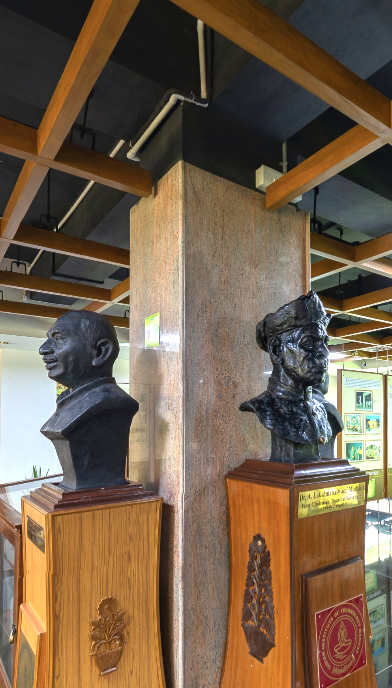Sub-assembly (outside view) of the geodesic dome that was designed by the FRP Centre
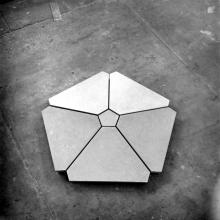
- Photographs , Equipment , 1970s
In 1970, when R. Buckminster Fuller received a gold-medal for his development of the geodesic dome, the American Institute of Architects called it “the strongest, lightest and most efficient means of enclosing space yet known to man.” The spherical form of the dome is composed of triangular facets, which can withstand pressure on all sides. Fuller discovered that a sphere created with triangles could have unparalleled strength. The geodesic dome (15 meters diameter) seen in image 0295 of this album was made out of pentagonal panels as seen in this photograph. Each panel was assembled using…
Sheet moulded components made at the FRP Centre
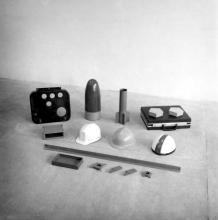
- Photographs , Equipment , 1970s
The sheet moulded components seen in the image are made from sheet moulding compounds (SMCs). SMCs are ready to mould glass-fibre reinforced polyester material primarily used in compression moulding. The Composite Structures (FRP) Research Centre, also known as the Fibre Reinforced Plastics (FRP) Centre was started at IIT Madras in March 1974. It was started due to the increased use of FRP, on a global scale, for advanced technology applications as well as for commercial and domestic applications. Prior to the formation of the Centre, in 1960, research and development activities in this…
An engineering drawing/sketch of a geodesic dome that was designed by the FRP Centre
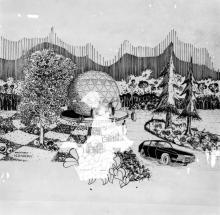
- Photographs , Equipment , 1970s
Seen in the image is an engineering drawing of a geodesic dome (15 meters diameter). IIT Madras set up six centres in the year 1973. The Composite Structures (FRP) Research Centre, also known as the Fibre Reinforced Plastics (FRP) Centre, was one of them. The centre was officially opened in March 1974 and it focussed on coordinating and utilising its expertise and resources to advance the research and development of FRP products. It also aimed at providing technical advice and leadership to the FRP industry in the country. The key objectives of the centre and services offered, as listed in…
Natural fibres used at the FRP Centre
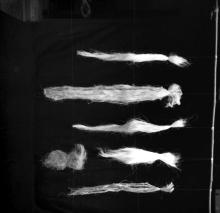
- Photographs , Equipment , 1970s
Natural Fibre Reinforced Polymer Composites or NFPCs are mostly used in non-load bearing indoor components in civil engineering because of their vulnerability to environmental attack. Some of the natural fibers used in the manufacturing of NFPCs are sisal, coir, oil palm, jute, pineapple, hemp and bamboo. The fibres seen in the image are possibly coir pith. IIT Madras set up six centres in the year 1973. The Composite Structures (FRP) Research Centre, also known as the Fibre Reinforced Plastics (FRP) Centre, was one of them. The centre was officially opened in March 1974 and its key…
A filament wound FRP tube that was made at the FRP Centre
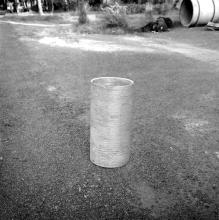
- Photographs , Equipment , 1970s
Filament winding is a process of manufacturing when individual filaments are run through a resin bath and wound onto a mandrel. Some of the products made using this technique of manufacturing are golf club shafts, automobile drive shafts, sailboat masts, oars and paddles for small boats, small aircraft fuselages, spacecraft structures and pressure vessels like fire-fighter oxygen bottles. The Composite Structures (FRP) Research Centre, also known as the Fibre Reinforced Plastics (FRP) Centre was started at IIT Madras in March 1974. It was started due to the increased use of FRP, on a…
An engineering drawing/sketch of the FRP canopy that was designed for the departure concourse at Madras Airport by the FRP Centre
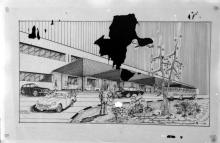
- Photographs , Equipment , 1970s
IIT Madras set up six centres in the year 1973. The Composite Structures (FRP) Research Centre, also known as the Fibre Reinforced Plastics (FRP) Centre, was one of them. The centre was officially opened in March 1974 and it focussed on coordinating and utilising its expertise and resources to advance the research and development of FRP products. It also aimed at providing technical advice and leadership to the FRP industry in the country. The key objectives of the centre and services offered, as listed in the 1974 IITM Annual Report: Research and development of raw materials and composites,…
An engineering drawing/sketch of a geodesic dome (15 meters diameter) that was designed by the FRP Centre
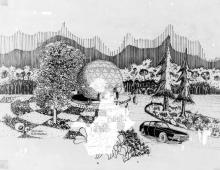
- Photographs , Equipment , 1970s
Seen in the image is an engineering drawing of a geodesic dome (15 meters diameter). IIT Madras set up six centres in the year 1973. The Composite Structures (FRP) Research Centre, also known as the Fibre Reinforced Plastics (FRP) Centre, was one of them. The centre was officially opened in March 1974 and it focussed on coordinating and utilising its expertise and resources to advance the research and development of FRP products. It also aimed at providing technical advice and leadership to the FRP industry in the country. The key objectives of the centre and services offered, as listed in…
A hydrochloric acid tank with a capacity of 15000 litres at the FRP Centre
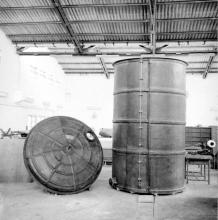
- Photographs , Equipment , 1970s
A hydrochloric acid tank is required to be resistant to strong acid’s corrosive effects as well as mitigate any potential HCL vapours. The tanks are generally manufactured from cross-linked polyethylene (XLPE), high-density polyethylene (HDPE), fibre reinforced plastics (FRP) and rubber lined carbon steel to 1.9 SG (ductile cast iron). IIT Madras set up six centres in the year 1973. The Composite Structures (FRP) Research Centre, also known as the Fibre Reinforced Plastics (FRP) Centre, was one of them. The Centre was officially opened in March 1974 and it aimed at coordinating and…
A Hydraulic Press at the FRP Centre
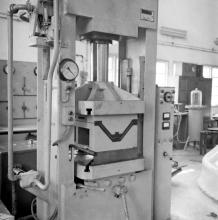
- Photographs , Equipment , 1970s
Seen in the image is a 150 tons Hydraulic Press that was used for press moulding studies. The Composite Structures (FRP) Research Centre, also known as the Fibre Reinforced Plastics (FRP) Centre was started at IIT Madras in March 1974. It was started due to the increased use of FRP, on a global scale, for advanced technology applications as well as for commercial and domestic applications. Prior to the formation of the Centre, in 1960, research and development activities in this area was initiated by the Department of Aeronautical Engineering (IIT Madras) because of the possible and…
Sub-assembly (inside view) of the geodesic dome that was designed by the FRP Centre
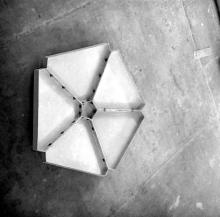
- Photographs , Equipment , 1970s
In 1970, when R. Buckminster Fuller received a gold-medal for his development of the geodesic dome, the American Institute of Architects called it “the strongest, lightest and most efficient means of enclosing space yet known to man.” The spherical form of the dome is composed of triangular facets, which can withstand pressure on all sides. Fuller discovered that a sphere created with triangles could have unparalleled strength. The geodesic dome (15 meters diameter) seen in image 0295 of this album was made out of pentagonal panels as seen in this photograph. Each panel was assembled using…
Natural fibres used at the FRP Centre
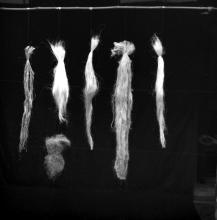
- Photographs , Equipment , 1970s
Natural Fibre Reinforced Polymer Composites or NFPCs are mostly used in non-load bearing indoor components in civil engineering because of their vulnerability to environmental attack. Some of the natural fibres used in the manufacturing of NFPCs are sisal, coir, oil palm, jute, pineapple, hemp and bamboo. The fibres seen in the image are possibly coir pith. IIT Madras set up six centres in the year 1973. The Composite Structures (FRP) Research Centre, also known as the Fibre Reinforced Plastics (FRP) Centre, was one of them. The centre was officially opened in March 1974 and its key…
An engineering drawing/sketch of a geodesic dome that was designed by the FRP Centre
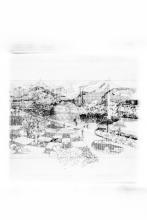
- Photographs , Equipment , 1970s
Seen in the image is an engineering drawing of a geodesic dome (15 meters diameter). IIT Madras set up six centres in 1973. The Composite Structures (FRP) Research Centre, also known as the Fibre Reinforced Plastics (FRP) Centre, was one of them. The centre was officially opened in March 1974 and it focussed on coordinating and utilising its expertise and resources to advance the research and development of FRP products. It also aimed at providing technical advice and leadership to the FRP industry in the country. The key objectives of the centre and services offered, as listed in the 1974…
Sub-assembly (inside view) of the geodesic dome that was designed by the FRP Centre
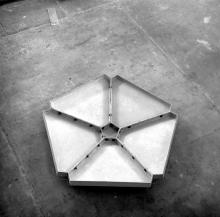
- Photographs , Equipment , 1970s
In 1970, when R. Buckminster Fuller received a gold-medal for his development of the geodesic dome, the American Institute of Architects called it “the strongest, lightest and most efficient means of enclosing space yet known to man.” The spherical form of the dome is composed of triangular facets, which can withstand pressure on all sides. Fuller discovered that a sphere created with triangles could have unparalleled strength. The geodesic dome (15 meters diameter) seen in image 0295 of this album was made out of pentagonal panels as seen in this photograph. Each panel was assembled using…
The Reading Hall of the Central Library, 1967
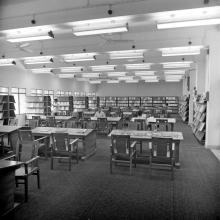
- Photographs , Campus Buildings, Campus Facilities, Academic Facilities , 1960s
The Central Library was opened on 21 July 1967 by Dr. A. L. Mudaliar (Chairman of the Board of Governors). This was the third place to serve as the IIT Madras Library, the first being on the third floor of A. C. College of Technology (until August 1961) and the second being on the second floor of the Building Sciences Block (until July 1967). As seen in the photograph, the building was well lit with natural light, owing to the plenty of windows that were built. The library was also equipped with a sufficient number of tube lights to provide ample lighting to readers.
A person browsing through a section of books in the Central Library, 1967
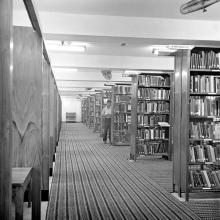
- Photographs , Campus Buildings, Campus Facilities, Academic Facilities , 1960s
According to the Annual Report of IIT Madras, 1967-68, the total stock of books and pamphlets in the Central Library rose from 61,439 from the start of the academic year to 69,799 on 30 June 1968. It included 58,860 books and 10,939 pamphlets. As seen in the photograph, the library was adorned with carpets and neatly arranged shelves. The library was also well equipped with lights and fans. Some of the sections that are visible are the ‘Mathematics’ and ‘Physics’ sections.
- Contribute
to the Centre -
Monetary
Support - Digital
Material

